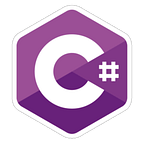C# is a modern, object-oriented programming language that is widely used for building Windows desktop applications, web applications, and games. If you are new to programming or new to C#, this guide will help you get started with coding in C#.
- Install Visual Studio: The first step to start coding with C# is to install Visual Studio, an integrated development environment (IDE) that makes it easy to write, debug, and test your code. Visual Studio is available for free download from the official Microsoft website.
- Create a new project: Once you have installed Visual Studio, open it and click on “Create a new project”. Select “Console App (.NET Framework)” or “Console App (.NET Core)” depending on your requirements. Give a name to your project and click on “Create”.
- Write your first C# code: Once you have created a new project, you will see the default code in the editor. The default code is a basic “Hello World” program that prints the message “Hello, World!” to the console. Let’s modify this code to make it more interesting.
using System;
namespace MyFirstCSharpApp
{
class Program
{
static void Main(string[] args)
{
Console.WriteLine("What is your name?");
string name = Console.ReadLine();
Console.WriteLine("Hello, " + name + "!");
Console.ReadKey();
}
}
}This code prompts the user to enter their name and then prints a personalized message to the console. Let’s break down this code line by line to understand what’s going on.
using System;: This line tells the compiler to include the System namespace, which contains many useful classes and methods that we will use in our code.namespace MyFirstCSharpApp: A namespace is a way of organizing related code into a container. Here, we have created a namespace called "MyFirstCSharpApp" to hold our code.class Program: A class is a blueprint for creating objects. Here, we have created a class called "Program" to define our main program.static void Main(string[] args): This line defines our main method, which is the entry point for our program. The "static" keyword means that we can call this method without creating an instance of the "Program" class. The "void" keyword means that the method does not return any value. "Main" is the name of the method, and "string[] args" is an array of command-line arguments that we can pass to our program.Console.WriteLine("What is your name?");: This line writes the message "What is your name?" to the console.string name = Console.ReadLine();: This line reads a line of text from the console and stores it in a variable called "name".Console.WriteLine("Hello, " + name + "!");: This line writes a personalized message to the console, using the value of the "name" variable.Console.ReadKey();: This line waits for the user to press a key before exiting the program.
- Run your code: To run your code, click on the “Start” button to build and run your code. You should see a console window appear with the message “What is your name?”. Enter your name and press Enter, and you should see a personalized message printed to the console.
- Learn more: This is just the beginning of your journey to learn C#. There are many resources available online to learn more about C#, including tutorials, documentation, and online courses. Some good resources to start with are the official Microsoft C# documentation, the C# Yellow Book by Rob Miles, and the C# Fundamentals for Absolute Beginners video series on Microsoft Virtual Academy.
- As you continue to learn and practice coding in C#, you will discover its many features and capabilities, such as object-oriented programming, LINQ, and asynchronous programming. You will also learn how to build more complex applications using C#, such as Windows Forms applications, ASP.NET web applications, and Unity games
